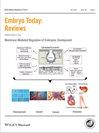Membrane-Mediated Regulation of Embryonic Development: Highlights
Q Medicine
引用次数: 1
Abstract
This issue of Birth Defects Research Part C: Reviews – EMBRYO TODAY, entitled “Membrane-Mediated Regulation of Embryonic Development”, features contemporary reviews of the important roles of membrane-mediated events in regulating critical events of embryonic development and postnatal functions. Ion channels are ubiquitous membrane components of all cells, including the zygote and blastomeres of the developing embryo, controlling ion currents that flow through these channels. Ion current mediated activity is important in signal transduction and the control of embryogenesis, from the early cleavage stages through to the development and growth of the embryo. Tosti et al. provide an overview of the occurrence, modulation, and dynamic role of ion fluxes taking place in the zygote and blastomere plasma membrane, as well intercellular communication, covering embryonic development from marine invertebrates to human. Membrane-mediated signaling events in the developing embryo are also critically dependent on and regulated by fundamental cellular activities. Wada et al. have reviewed a number of membrane-dependent activities that directly control cellular signaling. These include: (1) the secretory pathway, representing production of extracellular signal molecules; (2) the endocytotic pathway, a platform for relaying signals from the extracellular stimuli to intracellular mediators, and then ultimately inducing signal termination; and (3) post-translational modifications. Recent studies showing that dysfunction in membrane dynamics causes patterning defects in embryogenesis and tissue morphogenesis in mammals are also discussed. Successful pregnancy is dependent upon the implantation of a competent embryo into a receptive endometrium; however, implantation failure occurs in both normal pregnancies and those created artificially by assisted reproductive technology. The complex multi-step process of implantation begins when the developing embryo first makes contact with the plasma membrane of the epithelial cells within the uterine environment. Davidson and Coward have critically reviewed the physiological and molecular processes involved in this biological interaction that marks the beginning of a functional embryonic development, focusing on changes that occur in the plasma membrane of the uterine endothelium, and the molecular mechanisms that control communication between the early embryo and the endometrium during implantation. The molecular factors that have been implicated include endometrial integrins, extracellular matrix molecules, adhesion molecules, growth factors, and ion channels. In vitro models for embryo implantation to help researchers investigate mechanisms underlying implantation failure are also explored. Caveolae, an almost ubiquitous, structural component of the plasma membrane, play a critical role in many functions essential for proper cell function, including membrane trafficking, signal transduction, extracellular matrix remodeling, and tissue regeneration. Sohn et al. have summarized what is currently known about the structure, biochemistry, and biological activities of caveolae, and surveyed and explored the involvement of the caveolae and their constituent caveolin membrane proteins in normal development and how defects in caveolae/caveolin activities may be linked to lung and brain birth defects. Membrane-mediated activities are also critically important in specific embryonic organogenesis events and physiological functions. Hashimoto et al. review the biology of Eph receptors and their membrane-associated ligands, ephrins, originally recognized as markers of embryonic vessel identity, in vascular physiology. Elaborate coordination of Ephand ephrin-related signaling among different cell populations, and interactions of Ephs with ephrins at cell-to-cell interfaces underlie cellular responses such as repulsion, adhesion, attraction, and migration, which frequently occur during organ development, including vessel formation. There is also increasing recognition that Eph and ephrin proteins also have postnatal interactions with a number of other membrane-associated signal transduction pathways, coordinating translation of environmental signals into cells. The role and clinical significance of this signaling system in normal organ development, neoplasms, and vascular pathologies is also discussed. Makanya reviews membrane mediated development of the vertebrate blood-gas-barrier (BGB) in the embryonic lung, a process guided by epithelial tubes lined by columnar cells to yield an interface for efficient gas exchange. This thin BGB is achieved through processes, which entail lowering of tight junctions, stretching, and thinning in mammals. These processes occur within limited developmental *Address: Center for Cellular and Molecular Engineering, Department of Orthopaedic Surgery, University of Pittsburgh School of Medicine, 450 Technology Drive, Pittsburgh, PA 15219, Tel: 1-412-646-2603, Email: rst13@ pitt.edu胚胎发育的膜介导调控:重点
本文章由计算机程序翻译,如有差异,请以英文原文为准。
求助全文
约1分钟内获得全文
求助全文
来源期刊

Birth Defects Research Part C-Embryo Today-Reviews
DEVELOPMENTAL BIOLOGY-
CiteScore
3.65
自引率
0.00%
发文量
0
审稿时长
>12 weeks
期刊介绍:
John Wiley & Sons and the Teratology Society are please to announce a new journal, Birth Defects Research . This new journal is a comprehensive resource of original research and reviews in fields related to embryo-fetal development and reproduction. Birth Defects Research draws from the expertise and reputation of two current Wiley journals, and introduces a new forum for reviews in developmental biology and embryology. Part C: Embryo Today: Reviews
 求助内容:
求助内容: 应助结果提醒方式:
应助结果提醒方式:


